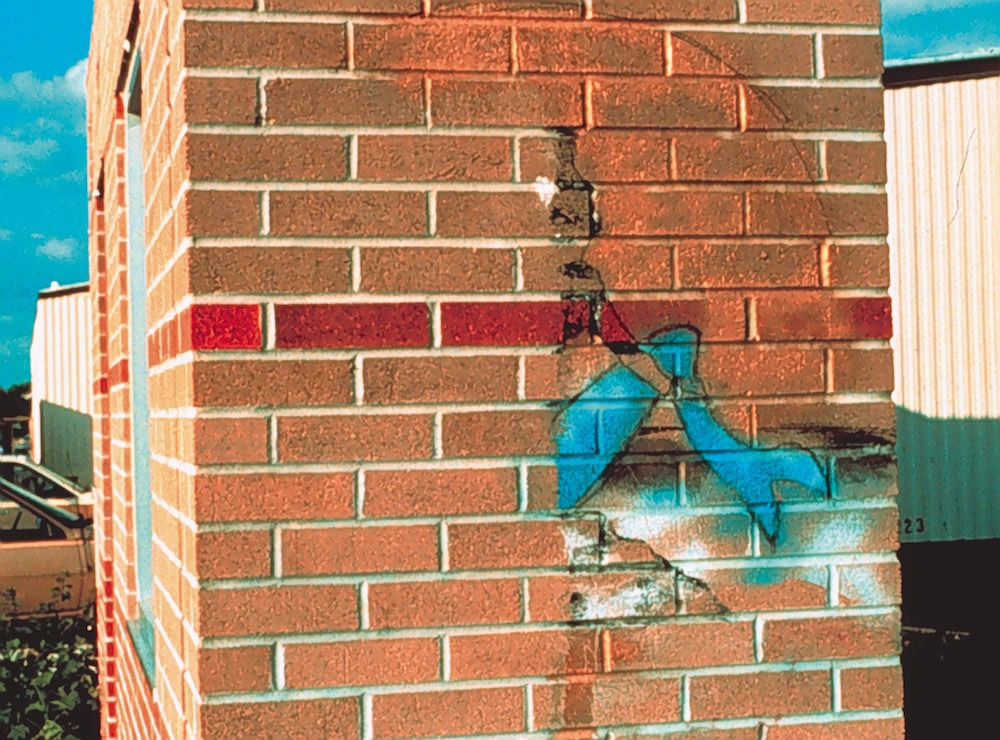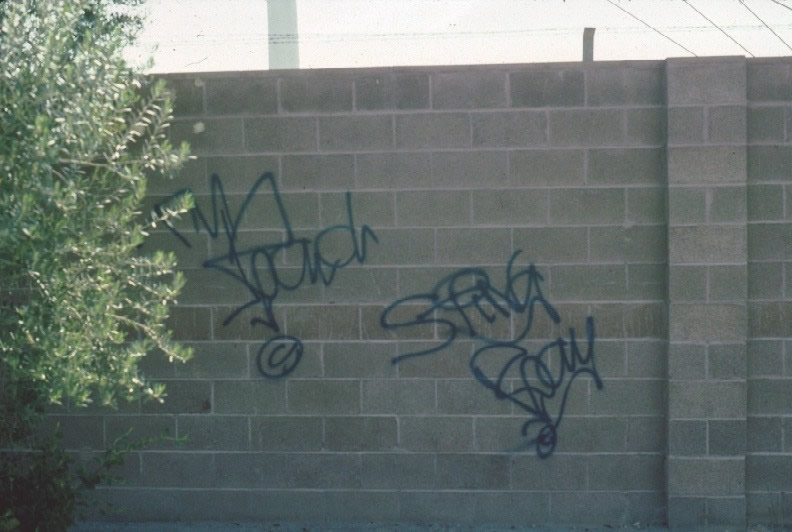How to Remove and Prevent Graffiti on Historic Masonry Exteriors
Words: Ashley Johnson
Words: Ashley Johnson
Photos: PROSOCO
Special thanks to Jake Boyer, Group Leader of PROSOCO, and Stephen Franks, Architectural and Technical Sales Expert for Hohmann & Barnard’s Diedrich Technology and Blok-Lok, Ltd.
Graffiti is a common problem and challenge that many building owners encounter. Many historic buildings are recognized for their iconic masonry, whether that be natural stone, marble, granite, brick, or something else. Masonry is an important architectural detail that adds character and historical significance to structures. Not only is graffiti a constant nuisance that requires painstaking planning to remove and prevent, but it damages and destroys the beauty of exterior surfaces.
Vandalism often is identified as spray paint but also can take the form of some other paint or permanent marker that is applied without permission to building exteriors. Graffiti though is not just damaging aesthetically. It is very expensive and labor-intensive to remove, and also can lead to decreased property values of 15 to 30 percent. Removing graffiti can cost businesses and cities anywhere from a couple hundred thousand dollars all the way into the millions of dollars.
The Impact of Graffiti on Masonry
What all types of masonry have in common is that they are porous, permeable, and sensitive to abrasion. Masonry also is sensitive to staining and scratches. The permeability of a surface will determine how effectively it will be cleaned and treated, as well as the methods implemented to clean and treat it.
Smooth surfaces like polished granite and marble are inherently easier to clean and remove defacing materials than brick or stone because their surfaces contain smaller pores. This makes it more difficult for graffiti and other forms of vandalism to penetrate. Brick, stone, and other materials with surfaces that are rough and porous allow paint and graffiti mediums to easily sink below the surface. This makes removal tedious and difficult. It also can cause more damage to the surface than the graffiti.
Most graffiti is identified by the use of spray paint composed of polyurethanes, lacquers, or enamel. But other materials are also common, such as brush applied paints made up of oils and synthetic resins.
Pigment or dye and binder are the two most common components in graffiti materials. Binder holds the pigment together as well as to the substrate. The solvent allows the pigment/binder combination to flow. Because paints are applied wet, when the solvent begins to evaporate, the binder solidifies. Paints with a higher solvent content increase their flow, which in turn increases their ability to penetrate surfaces.
The easiest and most effective method for removing graffiti is to address it as soon as possible, within hours of its application, so that the paint does not have time to cure. When the paint starts to dry, the pigment and solvent penetrates the building exterior and hardens over time. The longer that graffiti sits on the surface of a building, the harder it is to remove. Removing graffiti as soon as possible prevents atmospheric conditions from setting in, such as the sun baking the paint into the wall.
However, removing graffiti as soon as possible might not always be feasible or possible. When this is the case, it’s time to take other measures to remove the vandalism and restore the beauty of a structure’s masonry.
Planning for Graffiti Removal
Removing graffiti is a difficult task that takes planning and consideration for the materials involved. It can take weeks or months to remove vandalism. The type of material will determine how difficult it is to remove graffiti. Most masonry common in historical buildings, such as natural stone and brick, are porous in nature as mentioned above.
Fire-hardened brick, for example, consists of a tough outer surface that protects the interior from elements, such as rain, snow, and so on. Using abrasive cleaners, sandblasting, or power washing can remove the outer surface of brick and mortar. This causes the masonry to be susceptible to water damage and seeping. For older brick buildings, it’s best to use water and mild cleaners if possible.
When starting a graffiti removal project, it’s important to come up with a plan. This starts with identifying the type of graffiti used as well as the type of building material. Solvents and paint strippers can dissolve or break down paint and other graffiti, but if used incorrectly they can discolor exterior surfaces.
Different types of building materials and masonry have their own unique reaction to certain cleaning agents. These surfaces are typically classified by whether they are acid-sensitive, non-acid sensitive, or alkali-sensitive. Acid-sensitive building materials include limestone, marble, travertine, calcareous sandstones, shale, most polished stone, glazed architectural terra cotta, and glazed brick. It is advisable to avoid using acidic cleaning agents because of the potential damage caused to surfaces.
Non-acid sensitive masonry includes granite, slate, unglazed architectural terra cotta, and unglazed brick. Alkali-sensitive materials might contain silicates or ferrous, soluble iron compounds that can react to alkali and water to cause staining. These types of building materials include some types of granite, Indiana limestone, and many sandstone, especially sandstone that is gray or green.

Safety should always be taken into consideration when planning to remove graffiti. Always refer to the safety data sheet and product sheet of any graffiti removal product. Some products have different safety precautions than others with regard to skin sensitive, inhalation of fumes, and so on.
Methods for Removing Graffiti
There are multiple ways to clean and remove graffiti. The type of masonry material will also determine how the graffiti will be removed. It’s important to take into consideration the building material so as to preserve the exterior surface as much as possible.
The goal of removing graffiti from masonry should not just be the elimination and removal of vandalism. Any plan to remove graffiti should proceed in a manner that maintains and preserves the integrity of the building exterior while avoiding any significant, long-term damage.
Poulticing
Poulticing is a common way to remove graffiti. A poultice combines an absorbent material and a cleaning agent that is kept in contact with the graffiti on the building surface. The cleaning agent penetrates the masonry and softens the pigment, which is absorbed by the poultice. This type of cleaning method serves two purposes, one being that it allows a cleaning agent to stay in contact with the stained material as long as possible. The second purpose is to allow the cleaning solution to pull the staining material out of the substrate without re-depositing it.
Organic Solvents and Paint Removers
Most vandalism can be removed while protecting the surface material by using graffiti removal products and commercial paint strippers that contain organic solvents. Many paint removers are manufactured as a thick gel or paste that adheres to the surface. The advantage of using organic solvents is that they completely evaporate and leave no residue.
Organic solvents work best when used as a poultice but can also be toxic. Choosing the wrong type of cleaner can cause staining and damage that is worse than the graffiti. Another factor to take into account is the sensitivity of certain types of masonry to different chemicals.
Commercial paint strippers quickly remove graffiti by dissolving high strength paint and coatings that include epoxies, polyurethanes, enamels commonly found in spray paints used in graffiti. They are emulsified in water and then rinsed thoroughly with cold or hot water, or steam to flush spent cleaner and dissolved soiling from the surface. They are applied in a number of ways that includes using a solvent-resistant brush or roller.
Anti-Graffiti Protective Coatings
It is impossible to prevent graffiti, but with some types of treatments, it is possible to prevent it from bonding and causing long-term damage.
Masonry can be secured against graffiti through a series of water repellents that provide hydrophobic protection through the formation of a semi-permeable membrane. These flexible membranes offer protection to masonry surfaces that reject water in a solid state but allow moisture vapor transmission while remaining intact through the thermal movement of the masonry. The membrane protects masonry against spray paint and other common materials used by vandals that ultimately will penetrate deep into pores of exterior surfaces. With a unique blend of silicone polymers, these repellents provide the most resistance to destruction from UV light and acid rain while also providing protection against graffiti.

These barrier coatings can be applied year-round to most building exteriors as long as the temperature is above 20 degrees Fahrenheit. After the surfaces have been cleaned is the best time to use barrier coatings, usually within 90 days for new construction, or after restoration cleaning has taken place on older buildings. These protective and preventive coatings are clear and are applied to protect the appearance of the building.
Sacrificial Coatings
There are two types of graffiti protection coatings: sacrificial and non-sacrificial. Sacrificial coatings are paraffin wax based and applied to the substrate beforehand. The downside to these is that they don’t allow a building’s products to breathe. Sacrificial coatings also can cause sealer blush, which causes the wall to turn white and occurs when water tries to escape but is trapped by the wall
Non-sacrificial Coatings
These types of coatings applied to a building substrate and are typically silicon-based, allowing for natural breathability of the exterior. After non-sacrificial coatings are applied, graffiti can be removed over and over again while keeping the substrate intact and coated.
Whichever method of prevention is chosen, ultimately it makes removing graffiti easier because the substrate is properly protected, preventing the necessity of more aggressive products.
When using a preventative coating, there is a difference between temporary coatings and permanent coatings. Temporary coatings are removed every time graffiti is removed and must be reapplied. Permanent coatings do not have to be reapplied after graffiti is removed.
Graffiti is an inherent side-effect of cities and urban areas. While it is impossible to prevent, it is possible to prevent it from causing lasting damage. The better a building is protected, the better the appeal of the neighborhood and the preservation of its value and place in society.